The Huawei P8 Review
by Andrei Frumusanu on June 4, 2015 8:00 AM EST- Posted in
- Smartphones
- Huawei
- Mobile
- P8
- Kirin 930
Battery Life
The P8 has an typical 2680mAh (10.19Wh) enclosed battery which serves as the power source of the phone. This puts the expected lifetime of the P8 towards the lower range of today's smartphones, but given the rather efficient screen, it could go either way for the Huawei flagship.
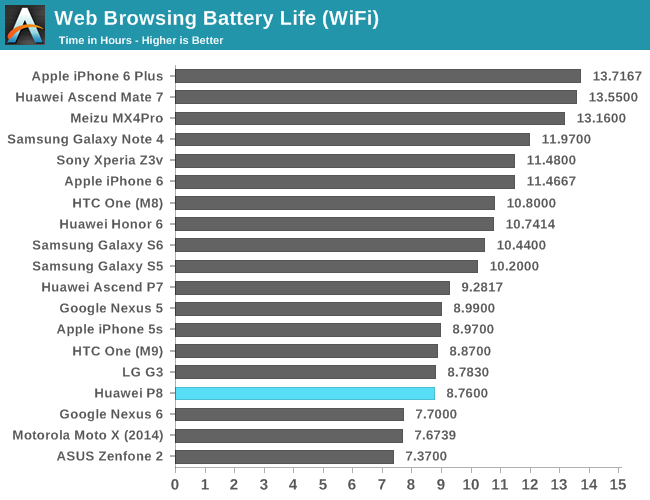
Starting off with our WiFi web-browsing test, we see the P8 achieve 8.76h of lifetime. Although, again, we have to mention that this doesn't particularly represent any groundbreaking number, it still is a good performance given the battery size of the phone.
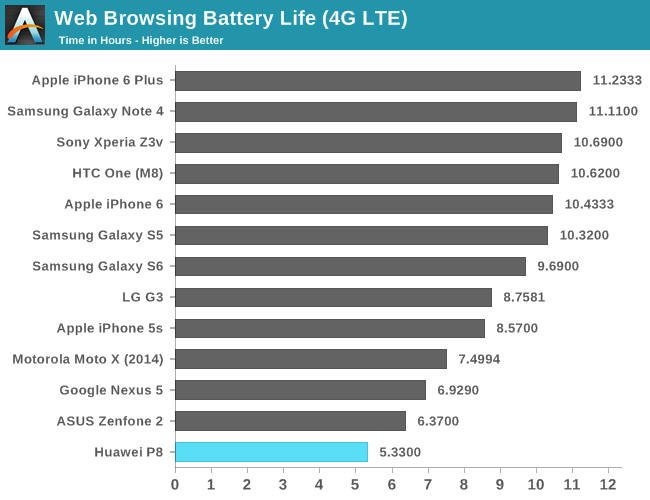
I've tried a go on LTE testing for the P8. In previous reviews I've mentioned that I had patchy coverage for 4G, but the P8 still managed to get an average reception. I'm not sure which frequency band it used, but I suspect it must have been the 1800MHz or 2100MHz band as the 800MHz band on my location is too weak and caps out at 0.2Mbps. As a reminder, this poses a discrepancy in the results as our other editors are able to test battery life under better signal conditions.
The HiSilicon Balong modem sadly performed very badly, coming in at only 5.33h. The device was getting noticeably warm when compared to the WiFi test - meaning the modem and RF system are at fault.
We now move on to PCMark battery test, which is a mixed load benchmark with web browsing, video playback, word processing and photo editing.
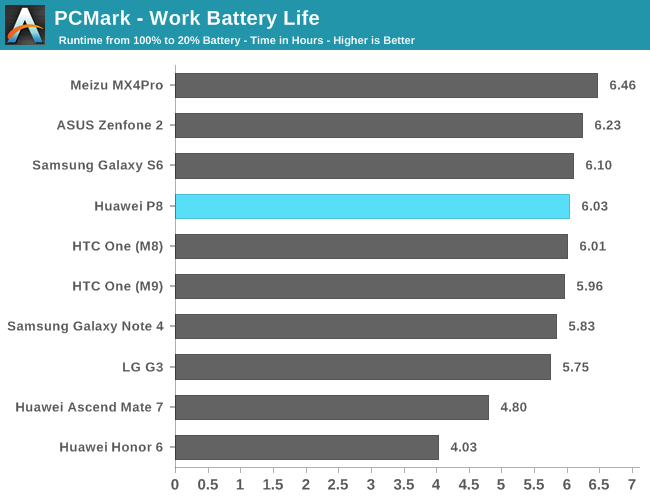
The P8 scored 6.03h, which is good and on par with other devices. This test in particular showed some horrid results for the Kirin 920 devices and showed off how inefficient that SoC could be during normal loads. One remark I would like to make is that the P8's battery life may be actually a tad higher as reported by PCMark because the test artificially stops when the battery gauge reaches 20%; I've noticed in other tests that the fuel-gauge in the P8 can be rather inaccurate, as the actual battery was able to still provide current for another half hour in our web tests even when showing 1% capacity. The same is valid on the other end, as the device will show 100% even though it will continue charging for another half hour after that.
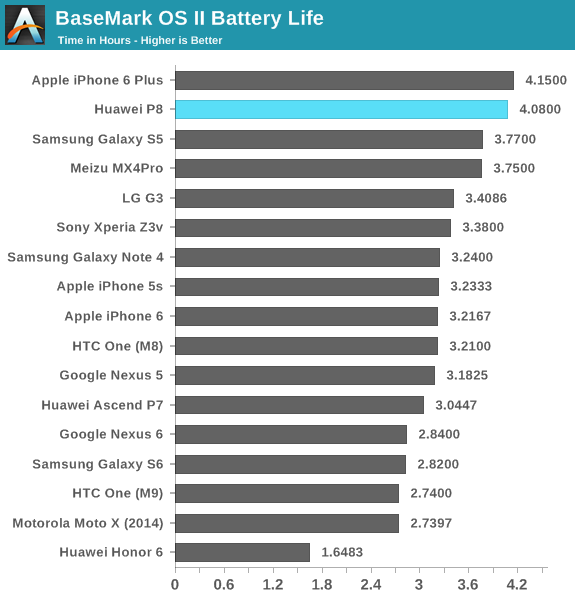
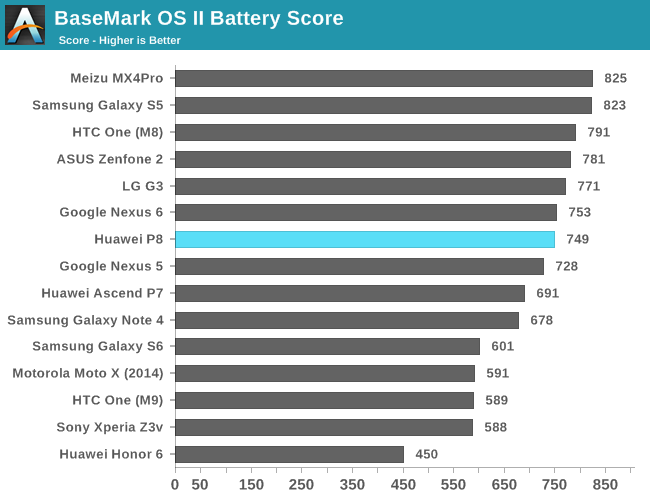
In BaseMark OS II's battery rundown test which stresses mainly the CPU with high loads, the P8 manages to score very well. This is an expected outcome as the Kirin 930 has no large CPU cores which could cause high power drain and lower the efficiency of the phone.
While I didn't have the proper tools to root the P8 to be able to get detailed power curves on the CPU cores, I again relied on the internal fuel-gauge to get some estimates through a CPU power virus.
| Huawei P8 Device Power & Kirin 930 CPU Load Power (Estimate as measured by internal fuel-gauge) |
||||||
| Avg. Total Power | Incremental Difference |
|||||
| Idle | ~0.91 W | - | ||||
| 1 Thread | ~2.48 W | ~1571mW | ||||
| 2 Threads | ~3.03 W | ~556mW | ||||
| 3 Threads | ~3.56 W | ~533mW | ||||
| 4 Threads | ~4.19 W | ~624mW | ||||
Idle power is measured at 200cd/cm² and comes in at around 0.91W. Looking at the incremental differences in power when adding additional threads seems to add somewhere in the region of 570mW. This is a reasonable number for a Cortex A53 core clocked at 2.0GHz on a 28nm process.
What is shocking though is the 1W overhead that happens when going from idle to 1 thread load. Theoretically what should be included in this figure is the power consumed by the performance cluster other non-CPU blocks coming out of their power-gated states. I haven't seen this behaviour happen on other SoCs such as from Samsung or MediaTek, where this overhead was usually only around 20% of a single core's power. This phenomenon is a tad worrisome as the impact on the Kirin 930's power efficiency could be quite large. This is definitely an aspect that warrants more investigation once I have the proper software tools for the P8.

On GFXBench, the P8 managed to perform well at 3.8h runtime, but only because the SoC throttles to ~45% of its maximum performance for about the whole duration of the run.
One notable metric that we don't really have a objective test-case for is idle battery life. Having now several devices in my collection I tend to leave them on on WiFi for extended periods without using them. The P8 was surprisingly bad in this metric as it only ever managed to survive for 2 to 3 days, while for example my Samsung devices are able to go up to 7-10 days under the same conditions and installed applications. I don't remember having quite as bad idle lifetime on the Honor 6 or the Mate 7, so I hope this is a software issue as opposed to increased power consumption by miscellaneous device components.
Charging Time
Althrough Huawei promised that the P8 would include a quick-charger by default during their London launch event, the actual device just had a normal 5W charger bundled in. In fact, the bundled accessories look nothing like the ones that were presented during the launch:
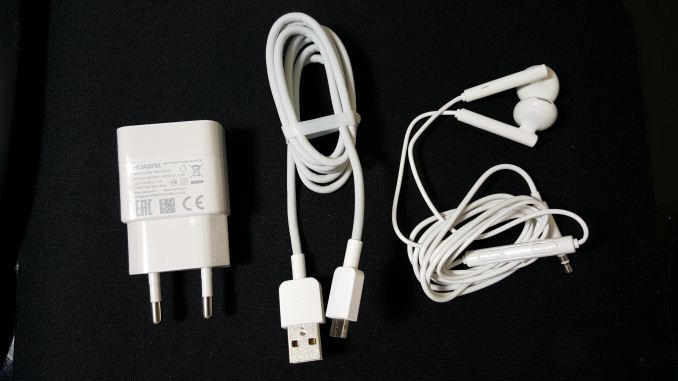
5.0V 1A charger... generic USB cable, similar but definitely not the same premium headphones ..
.. did we miss part of the story here?
Huawei offers also offers the device in more premium variants with a higher clocked 2.2 GHz SoC and 64GB of NAND memory, so there's the possibility that maybe the accessories for those versions differ too?
Nevertheless, I tried charging the phone with various other chargers with higher power outputs and voltages, but the P8 remained an exceptionally slow charger no matter what I connected it to.
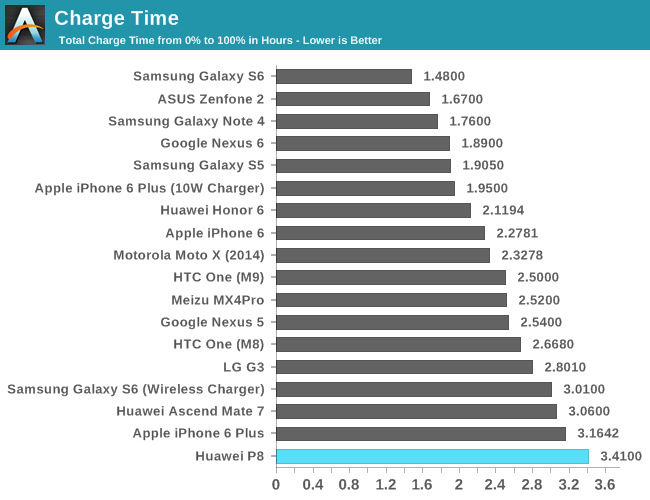
The end results is that the P8 is one of the slowest charging smartphones we've yet tested. While it's understandable that Huawei might have backed off the fast-charging claim in order to preserve the battery longevity of the P8, but having it charge even slower than Mate 7's 4100mAh battery is quite a feat in itself. A device teardown by IT168 revealed that the battery chemistry comes in at only 3.8V versus 3.85V such as in the Mate 7 and other modern devices, pointing out that Huawei chose to employ cheaper materials. Again we see the a quite misleading battery percentage gauge, as even though the P8 hits 100% after 175 minutes of charging, the battery still receives current for another 30 minutes until it is truly fully charged.
If you're low on battery and want to charge your device quickly, the P8 is definitely not the device for you, as it takes about an hour to charge only 40% of the battery.


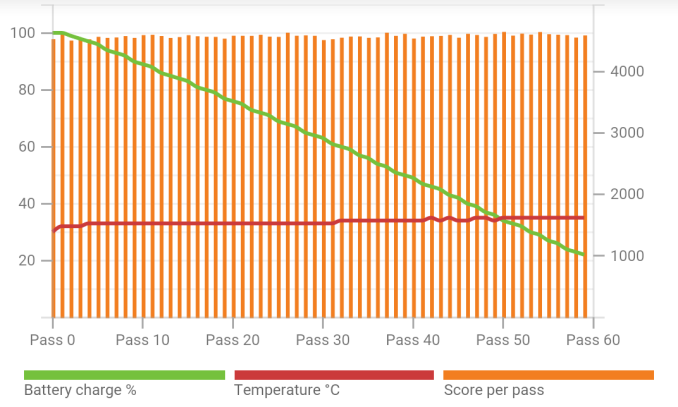

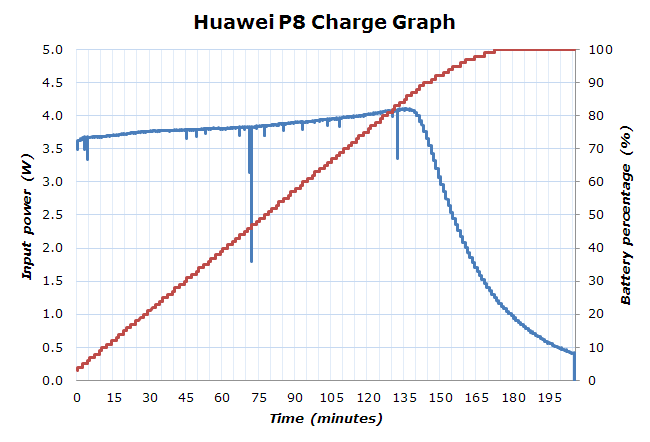








104 Comments
View All Comments
hrrmph - Thursday, June 4, 2015 - link
It's probably more useful than an iPhone for people who travel a lot and occasionally go off the grid, and thus need the device to still work as a GPS, camera, miniature computer, etc, while drawing all data from fast, convenient local storage...- It has a MicroSDXC slot, so it can take the new 200GB MicroSD storage cards; and
- It has dual SIMS.
Unfortunately, it lacks a user removable battery, so it is still inferior in that regard to each of the phones and phablets that I already have. But, in general, I like what they are doing.
Something that other nationals can tend to forget is that China has a lot of wealthy people (far more than the US or possibly even Europe). Even though these elite Chinese are wealthy, many of them are shrewd spenders. They want value for their high-end spend. So there is a lot of pressure on Chinese vendors to produce high-end devices that include every possible feature.
So just like Japanese enthusiasts used to get certain stereos and cameras that America only dreamed of, the Chinese are demanding that the manufacturers provide more fully functional high-end phones that can do everything... including the things that the iPhone cannot do.
That said, the iPhone is making headway in China too...
... but just like in the US, it's for all the wrong reasons. Namely, it's a jewelry piece that holds sway as a status symbol amongst the more vacuous of minds. Owning one supposedly elevates your perceived social status - much in the way that owning a ludicrously expensive sports car or ultra-luxury car does the same (think Rolls-Royce, Bentley, etc.).
Sociologists and psychologists have hypothesized that such objects are attractive to both the buyers who display them publicly and to those who view them, particularly the opposite sex.
People who buy these objects are subliminally advertising to potential mates that they have excess money that (under the proper circumstances) can in the future be re-directed to caring and tending for children and non-working spouses.
The attraction effect is generally stronger if the object is purchased and displayed by a male, because many societies still expect the male to bear the larger burden of providing financial resources. This is especially the case while the female is pregnant and in the early years of caring for children that aren't yet school aged.
The larger the excess spend over the practical value, the higher the perception of excess earning capacity. That's why we sometimes see phones sold with precious jewels encrusting them. Apple is just doing the same thing on a lower level... right out of the box. Charging more than the inherent underlying value.
So it's rather refreshing to see the Chinese manufacturers taking a different approach.
And it is especially refreshing to see the Chinese doing this in light of the fact that Samsung vacated the market as an Apple competitor and have now lowered themselves to merely matching Apple's product features. Without the Chinese, the Apple-Samsung twins (newly conjoined) don't really have any competition. The Chinese upping their game changes things.
Of course Apple can play this game too if they want. They simply need to offer more than 264GB of storage. The P8's 64GB of onboard NAND storage combined with the new SanDisk 200GB Micro-SDXC storage card will now set a very high bar that Apple needs to try to hurdle over (if Apple wants to be taken seriously with regard to storage).
I'm thinking that if Apple offers its next phone with 512GB of storage then that would safely secure the storage crown for them (remember, Samsung used to regularly double Apple's storage by simply adding a Micro-SD slot, but Samsung has now given up on competing).
Then Apple would need to add Dual-SIM slots to improve connectivity and travelability. It may come as a surprise to the uninformed that the newly wealthy Chinese (like many other nationals) are joining the tourist-corps. They are world travelers and they want their phones to work anywhere that they are likely to travel. Having Dual-SIMs makes it both convenient and affordable (roaming data charges are still the bane of the planet, even for wealthy Chinese).
I would also argue that to be better than what I've personally already got (and most Chinese, other Asians, Middle-Easterners, Africans, and Europeans already have), Apple would need to offer user removable back covers and batteries. Nothing says "I can handle a thirty hour multiple segment, multi-modal (air, sea, and land) journey" than a couple of lightweight fully-charged spare batteries. No awkward cables... just plop in and play on like nobody's watching.
So the Chinese phones are Apple clones? Nahh, this is just the Chinese practicing for the end-game. They want to do what Samsung used to regularly do to Apple: offer the consumer more for less... and the Chinese have just proven that they can win the storage crown. So who is to say they won't eventually win the various other races to provide the best-of-the-best on the other features? All it requires is Apple-Sung to remain lazy… which is something they have lately proven to be very adept at.
pityko - Thursday, June 4, 2015 - link
I signed up just to be able to thank you for this comment. You brilliantly summarised everything that's wrong with the current "leaders" of the mobile phone industry. I've been a Samsung user for years after being disappointed by the iPhone 3G then HTC in general but now when my contract expires for my Note 3 I am leaving for a Chinese brand, I want to support a company that hasn't given up trying.pgari - Thursday, June 4, 2015 - link
Always surprises me how people in these blogs write about what Apple "should do", but for what? To be even more successful? What are their credentials?Of course, anyone can say what they like or dislike. But the implicit assumption in most of these comments is "I know better", which is, at the least, presumptuous
Rod_Serling_Lives - Friday, June 5, 2015 - link
Well said. Apple already dominates with only a handful of devices and I don't know if they could be in a better position than they are currently.nathanddrews - Friday, June 5, 2015 - link
Personally, I don't like anything about Apple except the build quality of most of its products and its stock price. Cha-ching! I don't buy Apple products or use Apple software, but I'm happy the corporation is so successful. Deep down inside, I find myself horribly judging and mocking consumers of Apple products, but then I just have to remind myself not to feel bad about it. They're already dead inside.;-)
Brakken - Friday, June 5, 2015 - link
I think it's Tall Poppy syndrome... even ignoring everything else Apple has pioneered over the years and just looking at the Apple Watch - first gen of hardware and software, and it's amazingly smooth and will have years of support and development. With the hardware makers for Android, they are all dropping support for SD cards and removable batteries, except LG (?), but no one seems to talk about it when it happens. I think people start making 'I know better' statements because they don't check history.MarcSP - Saturday, June 6, 2015 - link
I agree with many of the things you said, but your theory about iphone as a status symbol is incomplete. I mean, according to what you said it seems that most buyers should be single men, and I have seen as many women as men with iPhone in Shanghai (maybe more, as female tend to follow fashion very strongly, and most cannot choose a phone based on "tech" or "features").Also, many married couples and middle aged and old persons use iPhone. Even students have them.
It always strikes me, because in China iPhone's price is quite higher than the average salary in the first tier cities. Imagine if an iPhone cost 2000 USD in the US. Nobody would buy it, but in china they do.
I guess mostly because the "status symbol" thing, but not to impress potential sexual partners, just to say "hey, look, I am NOT POOR", even if you are and cannot afford a health insurance and use recycled oil for cooking. After the communist times, Chinese socity has gone to the other extreme. Now being poor is not just pityful, it is shameful. No matter how, even if you have to sell tainted milk to babies or steal from your fellow citizens with lies, you MUST become rich. Of course, most cannot, so that's why they think having a "symbol" is better than nothing. "Appearence" is king nowadays in China, not "substance". I guess they need 20 more years to find a balance. Too many changes, too fast.
Ethos Evoss - Friday, June 12, 2015 - link
jesu su writing a book ?jjj - Thursday, June 4, 2015 - link
You wish the iphone had a sane design like this instead of their roadkill look.puremind - Thursday, June 4, 2015 - link
If Apple had cloned this device, it would have been better. Instead of the huge bezels it would have had a much more usable form factor.